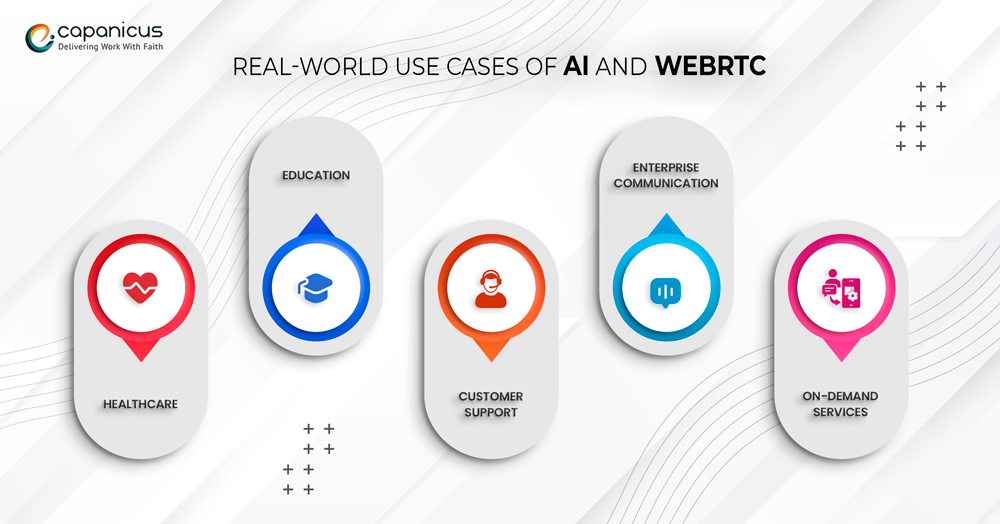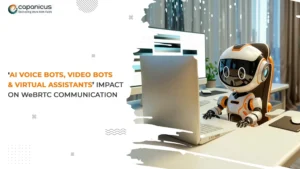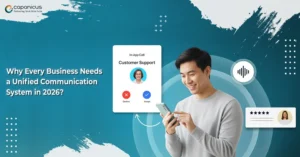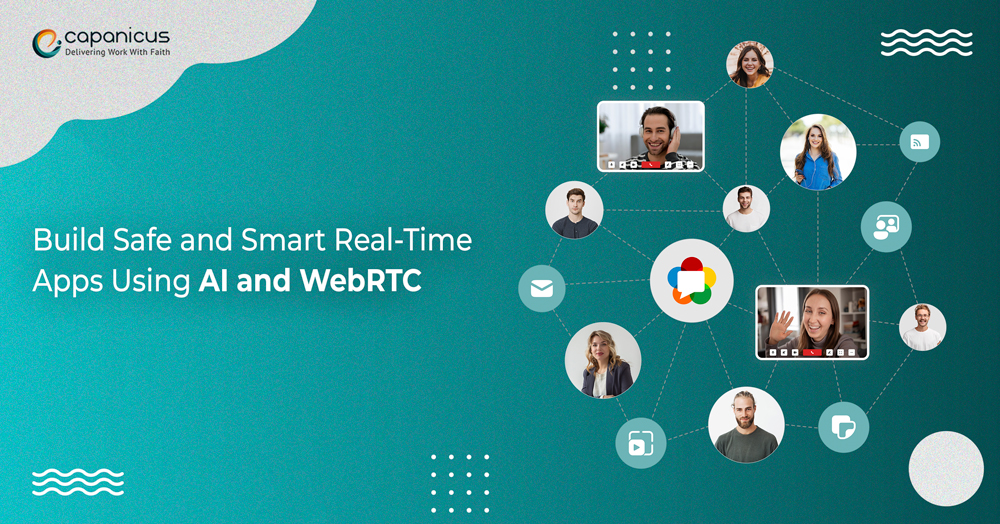
Real-time communication has become a must in today’s digital world, which moves rapidly and is very interactive. The success of business dealings, customer engagement, remote collaboration, and many more is dependent on it. So, whether the idea is live customer support, instant video conferencing, or AI-driven communication tools, users want to have them every time as simple, safe, and smart as possible.
This is the point where the Artificial Intelligence (AI) and Web–Real–Time–Communication (WebRTC) technologies’ conjunction comes with extensive influence to reshape the business design of Global Real-time Solutions.
Real-time connection is the main driver in WebRTC
WebRTC (Web Real-Time Communication) is a combination of libraries and standards easing real-time sharing of video, voice, and data among participants of the sessions, which run in browsers or mobile apps with no additional software or hardware necessary.
The characteristic that has put WebRTC at the forefront is the one that allows it to offer instant, low-latency communication which is very close to a need in almost the whole market of telehealth, education, finance, customer support, and on-demand services.
The advent of daily usage, including from video calling platforms like Google Meet to interactive live-streaming apps and online learning tools, has been powered by the WebRTC (or commonly known as WebRTC) development.
However, it should be noted that businesses could not be fully satisfied with WebRTC technology alone. Speed is no longer the only parameter of communication businesses’ demand; they require intelligent, automated, and safer communication instead. This is where the AI-powered WebRTC comes.
The Role of AI in Transforming Real-Time Applications
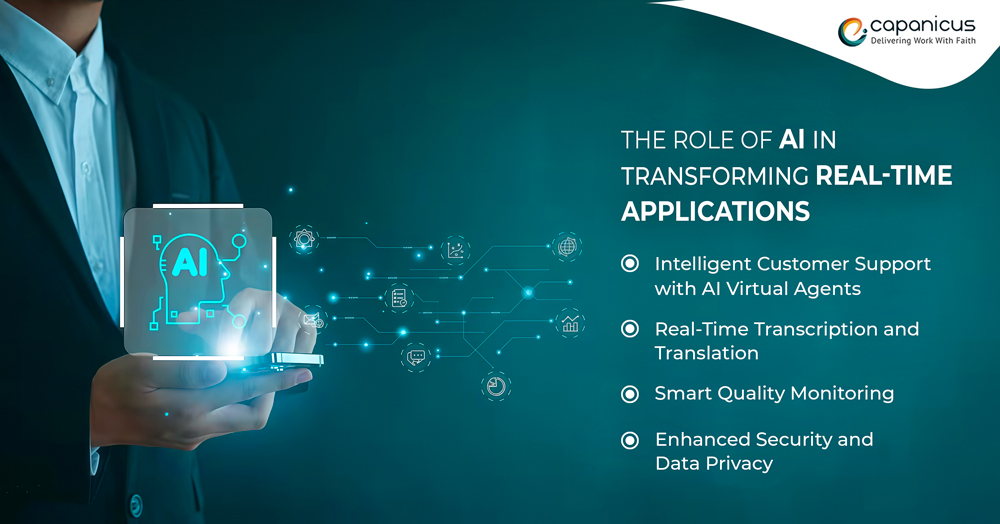
Incorporating AI technologies into live interaction applications opens the door to a fresh, higher degree of user-centricity and the application of resources in a smarter way. With the help of AI, it is feasible to extend the limitations of typical calls or text messages to the realization of comprehension, instant response, and even the preemption of user requirements by the devices.
Here’s how AI enhances WebRTC-based communication:
- Intelligent Customer Support with AI Virtual Agents
One of such AI Virtual Agents is the Customer Support AI, which is in the process of being re-shaped by itself and is subsequently creating a new Customer Support paradigm-driven by AI cognition – the web/mobile-based conversational agents that can accept questions in natural language, provide matching answers from the knowledge-base or documentation, learn continuously by interaction, generate reports or summaries, and even feel user psyches through voice or text.
While such AI Virtual Agents are combined with WebRTC services, the real-time voice and video interactions enabled by them are considered the most efficient and advanced communication technologies that keep the user at the center of the interaction and, at the same time, allow for a seamless transaction with the system. Visualize a support bot being able to do all these functions at once – sensing, hearing, responding – thus ensuring customer satisfaction promptly without the need of handing over to a different agent.
- Real-Time Transcription and Translation
In an integrated AI and WebRTC environment, front-end applications are endowed with capabilities such as on-the-fly transcription, speech recognition, and interpretation during a call or conference scenario. This feature is truly a game-changer for businesses with international clients, as it bridges language barriers among distant locations, thus contributing to the creation of a global village of both corporate professionals and potential customers, accessible and inclusive of all
- Smart Quality Monitoring
AI algorithms can, in real time, supervise and improve call quality just as they are working. They do so by identifying delays in the network, missing packets, and low audio or video quality, and they even reconfigure the bandwidth usage automatically, so that any dialogue can be heard clearly and without any break.
- Enhanced Security and Data Privacy
The issue of security is among the top concerns when it comes to real-time applications. AI has a big part to play in the entire WebRTC secure framework, as it is by the way it identifies communication changes for the presence of abnormalities, risks of break-ins, or unauthorized access that it is able to keep the data secure from the source to the end.
Why Businesses Are Turning to AI + WebRTC Development
Old-fashioned communication tools do not meet the requirements of today’s businesses. They require platforms that can do this – adapt, learn, and progress – thus providing personalized, real-time experiences even to a large number of users.
The blend of WebRTC development and AI solutions offers the following unprecedented advantages:
- Seamless Real-Time Collaboration
The implementation of AI in real-time communication, as in WebRTC, simply opens up collaboration across staff who are using different devices, even in different offices; the only requirement is internet connectivity. A sales demo, an internal meeting, or customer onboarding becomes instant and uninterrupted in all of them in the same way.
- Smarter User Interactions
Artificial intelligence gets all the help it needs from machine learning and natural language processing, and hence can determine not only the tone but also the sentiment and intent of your WebRTC application, thus taking it to the next level and making it possible to have smart responses. This, in turn, helps businesses offer personalized experiences that make users feel understood and valued.
- Scalability with Efficiency
The use of AI technology in communication enterprises releases human workers from doing repetitive tasks, it regulates the internet traffic prudently, and even predicts the server loads. As a result, this allows businesses to expand their communication solutions easily and without any hindrance in their performance or user experience.
- Better Analytics and Insights
The setting up of AI in the WebRTC program, on the other hand, makes it possible to gather communication data, analyze it, and thus, have it as a base for insights on customer satisfaction, engagement levels, and agent performance. This, in turn, facilitates a firm in obtaining higher service quality and being more responsive consistently.
Real-World Use Cases of AI and WebRTC
Let’s look at some industries already leveraging this powerful combination:
- Healthcare
AI + WebRTC telehealth platforms are setting up just-in-time video interactions, including automated patient triage, transcription, and health data analysis, which, along with security being ensured, give the user comprehensive accessibility.
- Education
Digital learning solutions integrate WebRTC live class functionality with the co-located usage of AI for attendance monitoring, participation analytics, and providing real-time translation for language-diverse classrooms.
- Customer Support
One of the ways support centers make use of AI Virtual Agents is by connecting them with WebRTC channels so that live assistance can be offered 24/7, thus human workload will be lightened, but customer satisfaction will still be retained.
- Enterprise Communication
Companies act on the development of AI-powered WebRTC platforms for the purposes of their intranet communications that are secure, automated meeting summaries, and voice-based authentication systems.
- On-Demand Services
Ride-hailing and service apps have all benefited from WebRTC development since it made live driver-customer communication possible. In the meantime, AI is in charge of routing, feedback, and service optimization.
Security: Building Safe Real-Time Applications
Security is an absolute must in any real-time communication platform. Even though WebRTC by itself implements very strong encryption standards (such as DTLS and SRTP), a combination with AI-driven security layers gives an edge over the already existing security.
These are some AI and WebRTC integration security advances:
- Threat Detection: AI uses the results of the last few calls to detect abnormal patterns of behavior, like attackers’ attempts to leak data unknowingly.
- User Authentication: Identification supported by the AI, including features like recognition of the human face or the voice, offers optimum protection of the identity.
- Data Privacy Compliance: AI-driven tools enable automatic international privacy law (GDPR and others) compliance.
Such a combination results in a situation where data, privacy, and communication integrity are totally protected – the demand that has become the norm for both businesses and users of today.
How Capanicus Leads in AI and WebRTC Development
At Capanicus, we create custom real-time communication solutions
that combine the power of AI and WebRTC to deliver next-generation performance
and safety are what we are known for.
We have the following expertise:
- WebRTC full cycle development – starting from design up to implementation.
- The introduction of AI Virtual Agents to automate routine tasks.
- Security technologies based on encryption, along with the prevention of data breaches.
- The AI solution that can be adapted for your company’s growth.
Develop a customer engagement platform, healthcare application, or an enterprise communication system. Our WebRTC services will ensure all your connections remain smooth, with high-quality live interaction, and provide you with trusted security.
The Future: Smarter, Safer, More Human
The synergy between AI and WebRTC is not just another tech trend; it is the base for the future digital ecosystem. User demands for real-time, intelligent, and secure interactions are becoming the norm, so businesses that take this combined path will be the first to react to new requirements. First, by embedding AI solutions into WebRTC-based communication, companies are not only allowing better connections, but they are also producing AI-powered, meaningful, humanized experiences to grow wider.
Final Thoughts
It has become a necessity rather than a choice, the building of smart and safe real-time apps- a factor that has a direct correlation to the company’s growth, trust, and success in the long run. The combination of AI and WebRTC mobile apps makes business communication not only faster and smarter but also more secure than ever before. At Capanicus, we are making the change for businesses all over the world.









